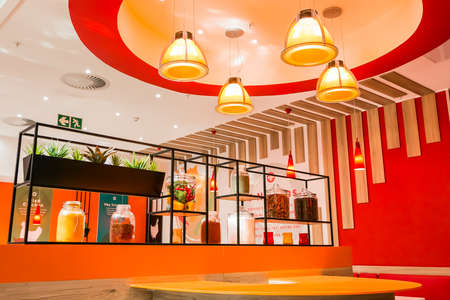Understanding the Importance of Reception Areas in Indian Businesses
In the vibrant landscape of Indian commerce, the reception area holds a position of unique cultural and commercial importance. This space is not just a physical entry point—it serves as the face of an organisation and establishes the first impression for clients, visitors, and potential partners. In India, where traditions of hospitality such as Atithi Devo Bhava (The guest is equivalent to God) play a pivotal role in daily interactions, the way a reception area is designed and managed reflects deeply on a company’s respect for its guests. More than simply welcoming visitors, these areas communicate core brand values, professionalism, and the organisational culture at first glance.
Indian businesses often blend modern aesthetics with traditional elements—such as motifs inspired by local art, religious symbols, or even Vastu-compliant layouts—to create a sense of belonging and warmth. The reception becomes the initial touchpoint for building trust, fostering relationships, and conveying a business’s commitment to service excellence. As competition intensifies across sectors from IT to hospitality and manufacturing, the strategic integration of brand identity and cultural nuances within reception areas becomes increasingly significant for both differentiation and success in the Indian market.
Reflecting Indian Brand Identity Through Design
Integrating brand identity with Indian cultural aesthetics in reception areas is a strategic move for businesses aiming to create an authentic and memorable first impression. By thoughtfully blending corporate values with local traditions, companies can communicate trust, credibility, and a strong sense of belonging. Below are practical approaches Indian businesses can take to infuse their unique identity and rich heritage into reception area layouts.
Incorporating Indian Colours & Motifs
Colours play a significant role in both branding and Indian culture. For example, saffron denotes energy and strength, while green symbolizes growth and harmony. Businesses can align their brand palette with these hues or use them as accent colours in furnishings and wall art. Traditional motifs such as paisleys, mandalas, or geometric jaali patterns can be featured on walls, floors, or reception desks to evoke familiarity and pride.
Blending Traditional Art Forms
Reception spaces can showcase India’s artistic diversity through curated displays of Madhubani paintings, Warli murals, or handwoven textiles. Incorporating these art forms not only personalizes the space but also supports local artisans. Choose artworks that resonate with your brand’s story—whether it’s innovation, sustainability, or social responsibility—to strengthen the narrative you wish to convey.
Practical Elements for Reception Area Integration
| Element | Indian Cultural Reference | Brand Integration Tip |
|---|---|---|
| Furniture | Teak wood benches, carved stools | Add subtle branding via engraved logos or custom upholstery in brand colours |
| Lighting | Jaali-patterned lamps, brass diyas | Select fixtures that reflect both brand aesthetics and traditional craftsmanship |
| Flooring | Kota stone, terracotta tiles, rangoli designs | Use floor graphics or rugs featuring company values in regional scripts |
| Art & Decor | Madhubani paintings, Warli art | Curate pieces that echo core brand messages (e.g., teamwork, innovation) |
| Reception Desk | Paisley carvings, ethnic inlays | Incorporate subtle design cues inspired by your logo or tagline |
Cultural Symbolism Meets Contemporary Branding
The key is balance: too much tradition may overshadow modernity; too little may feel disconnected. Aim for harmony by integrating cultural elements in moderation—perhaps a mural behind the reception desk paired with sleek, branded signage. Consistency across all design elements reinforces the message that your business respects its roots while embracing progress.

3. Incorporating Local Culture and Traditions
For Indian businesses aiming to leave a memorable impression on visitors, integrating local culture and traditions into reception areas is not just an aesthetic choice—it’s a strategic move that fosters familiarity and respect. Aligning these spaces with Indian values, beliefs, and regional diversity helps clients and stakeholders instantly connect with your brand at a deeper level. Below are practical strategies for weaving elements like Vastu Shastra, traditional artefacts, and regional aesthetics into your reception design.
Embracing Vastu Principles for Positive Energy
Vastu Shastra, India’s ancient architectural science, remains influential in contemporary workspace design. Positioning the reception desk facing east or north, using earthy colours, and ensuring open, clutter-free entryways are believed to invite prosperity and positive energy. Many Indian clients appreciate such thoughtful adherence to tradition, which demonstrates cultural sensitivity and consideration for their well-being.
Showcasing Traditional Artefacts and Craftsmanship
Displaying curated artefacts—such as terracotta sculptures, brass lamps (diyas), or handwoven textiles—not only beautifies the space but also pays homage to India’s rich artistic legacy. Consider sourcing pieces from local artisans representing various states: Madhubani paintings from Bihar, Tanjore art from Tamil Nadu, or Warli motifs from Maharashtra. This approach highlights your commitment to supporting indigenous crafts while celebrating India’s vibrant heritage.
Infusing Regional Aesthetics in Design
The diversity of Indian culture can be reflected through region-specific design cues. For example, use Rajasthani jali work for decorative partitions, Kerala-style wooden ceilings, or Kashmiri carpets for warmth underfoot. Colour schemes inspired by Indian festivals—like the reds and golds of Diwali or the pastels of Holi—can create an inviting yet culturally resonant atmosphere that appeals to both local and international guests.
Personalising Experiences for Stakeholders
To further strengthen connections with clients and stakeholders, tailor elements in the reception area based on the predominant culture of your target audience. For instance, incorporating subtle motifs from the client’s home state or region communicates attention to detail and personalisation—a hallmark of Indian hospitality.
Conclusion
By thoughtfully integrating Vastu principles, traditional artefacts, and regional aesthetics into your reception area, you create a welcoming environment that reflects both brand identity and cultural understanding. This not only enhances first impressions but also reinforces trust and belonging among Indian clients and stakeholders.
4. Welcoming Approach: Hospitality with an Indian Touch
In India, hospitality is more than just a gesture; it is an integral part of the culture that can significantly enhance the reception area’s role in expressing your brand identity. Integrating traditional Indian hospitality practices into your reception strategy not only makes visitors feel valued but also reinforces a distinct, memorable brand impression rooted in local values.
Chai and Refreshments: A Warm First Impression
Offering chai or coffee is a time-honoured Indian custom that instantly communicates warmth and friendliness. By serving regional beverages or snacks, businesses can create an inviting environment while subtly reflecting their brand’s commitment to comfort and care.
| Hospitality Element | Implementation Tip | Branding Benefit |
|---|---|---|
| Chai/Regional Beverages | Serve masala chai, filter coffee, or local coolers in branded cups | Associates brand with tradition and attention to detail |
| Traditional Snacks | Offer items like samosas, khakhra, or laddoo during festivals or special events | Cultural connection and festive atmosphere |
| Aromatic Welcome (e.g., agarbatti) | Use subtle traditional fragrances at the entrance | Sensory branding, creates a calming ambience |
Indian Greetings: Language as a Bridge
A warm “Namaste” or “Vanakkam” at the reception desk goes beyond mere politeness—it demonstrates respect for guests’ backgrounds and resonates deeply with Indian sensibilities. Training staff to greet visitors using local languages or region-specific phrases personalises the experience and strengthens the cultural connection.
Sample Greeting Phrases by Region:
| Region/Linguistic Group | Greeting Phrase | Usage Tip |
|---|---|---|
| Northern India (Hindi) | Namaste / Namaskar | Use for most North Indian guests and pan-India settings |
| Tamil Nadu (Tamil) | Vanakkam | Add when welcoming South Indian visitors from Tamil Nadu |
| Bengal (Bengali) | Nomoskar / Nomoshkar | Ideal for Bengali-speaking guests or business partners |
| Maharashtra (Marathi) | Namaskar / Namaskara | Acknowledge Marathi-speaking visitors with this greeting |
| Karnataka (Kannada) | Namaskara | Add regional touch for Kannada-speaking clientele |
The Power of Personalisation in Reception Spaces
Combining these hospitality elements—authentic refreshments, culturally resonant greetings, and sensory touches—creates an environment where every visitor feels acknowledged and comfortable. This approach enhances your brand’s image as approachable, respectful, and locally attuned. Ultimately, integrating Indian hospitality traditions into your reception area builds lasting positive associations between your brand and its stakeholders.
5. Consistency Across Multiple Locations
For Indian businesses with branches across different states or cities, ensuring brand and cultural consistency in reception areas is crucial. India’s diverse regional identities mean that each location has its unique customs, languages, and design sensibilities. However, a consistent brand image builds trust and recognition among clients, partners, and employees nationwide. By establishing standard guidelines for décor elements—such as logo placement, brand colours, and signature motifs—companies can create a unified experience, whether the office is in Mumbai, Bengaluru, or Kolkata.
At the same time, it’s important to localise certain aspects without compromising the core identity. For instance, while all reception areas should reflect the company’s values and aesthetic, incorporating region-specific artwork or greeting practices (like a Namaste gesture or displaying local handicrafts) helps visitors feel welcomed and respected. This blend of uniformity and localisation demonstrates cultural sensitivity while strengthening overall brand integrity.
Consistent messaging in signage, staff uniforms, and welcome materials further reinforces a professional image. It also streamlines staff training and customer expectations across locations. By prioritising both brand alignment and respectful nods to local culture, Indian businesses can create memorable first impressions that resonate across linguistic and cultural boundaries.
6. Practical Tips and Case Studies
Actionable Tips for Reception Area Transformation
1. Embrace Local Art and Craftsmanship
Incorporate traditional Indian art forms such as Madhubani, Warli, or Tanjore paintings within your reception area décor. This not only creates a strong visual identity but also resonates with local pride and culture. Tata Consultancy Services (TCS) integrates hand-painted murals from various Indian states in their offices, subtly reflecting their pan-India presence.
2. Use Brand Colours and Motifs Strategically
Leverage your corporate colours in the furnishings, accent walls, and even uniforms of front-desk staff. Infosys’s Bengaluru campus uses blue accents throughout its reception, reinforcing its brand while maintaining a serene ambience that appeals to both Indian and international visitors.
3. Offer a Warm, Culturally Relevant Welcome
Train reception staff to greet guests with a traditional ‘Namaste’ or offer welcome drinks like chai or coconut water. ITC Hotels have made this practice part of their guest experience, blending hospitality with Indian cultural values.
4. Showcase Company Legacy and Values
Display awards, milestones, and stories about the company’s journey through visually appealing panels or digital screens in the reception. Mahindra & Mahindra displays its legacy through a timeline wall that features both historical milestones and core values, making every visitor aware of what the brand stands for.
5. Incorporate Greenery and Vastu Elements
Add indoor plants or follow simple Vastu principles to create a harmonious environment. Godrej Properties integrates lush green vertical gardens in their receptions, which not only enhance aesthetics but also align with eco-friendly values deeply respected in Indian society.
Case Study: Asian Paints’ Vibrant Reception Makeover
Asian Paints revamped its Mumbai head office reception by combining modern design with vibrant colour palettes inspired by India’s festivals. They integrated local textile patterns into soft furnishings and used digital art installations depicting their journey across India. The result is a welcoming space that instantly communicates the brand’s creative spirit and deep cultural connection.
Key Takeaway for Indian Businesses
A thoughtful fusion of brand identity and Indian culture transforms reception areas into powerful storytelling spaces—making clients, partners, and employees feel valued from the very first step inside your office.


